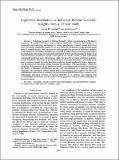Por favor, use este identificador para citar o enlazar a este item:
http://hdl.handle.net/10261/57502COMPARTIR / EXPORTAR:
 SHARE SHARE
 CORE
BASE CORE
BASE
|
|
| Visualizar otros formatos: MARC | Dublin Core | RDF | ORE | MODS | METS | DIDL | DATACITE | |

| Campo DC | Valor | Lengua/Idioma |
|---|---|---|
| dc.contributor.author | Herrera, Carlos M. | - |
| dc.contributor.author | Jovani, Roger | - |
| dc.date.accessioned | 2012-10-08T11:23:40Z | - |
| dc.date.available | 2012-10-08T11:23:40Z | - |
| dc.date.issued | 2010 | - |
| dc.identifier | doi: 10.1890/09-0849.1 | - |
| dc.identifier | issn: 0012-9658 | - |
| dc.identifier.citation | Ecology 91: 422- 430 (2010) | - |
| dc.identifier.uri | http://hdl.handle.net/10261/57502 | - |
| dc.description.abstract | Individual variance in lifetime fecundity within populations is a life-history parameter of crucial evolutionary and ecological significance. However, knowledge of its magnitude and underlying mechanisms in natural populations is biased toward short-lived taxa. This paper summarizes results of a 23-year study on a population of the Mediterranean shrub Lavandula latifolia. We document the within-population pattern of individual variation in instantaneous and lifetime fecundity (as estimated by inflorescence production) and explore the mechanisms producing the lognormal distribution of individual fecundities by means of an individual-based simulation model. Throughout the study period, a few individuals consistently produced most inflorescences while the majority of plants exhibited moderateto-low fecundities. The shape of yearly distributions of annual fecundities varied little across years, and most annual fecundity distributions did not depart significantly from a lognormal. The distribution of individual lifetime fecundity did not depart from lognormality. Despite the simplicity of the premises of our simulation model, it was remarkably successful at predicting the shapes of fecundity distributions and the early establishment of a persistent fecundity hierarchy. The agreement between model results and empirical data supports the view that multiplicative interactions of randomly varying environmental effects can play a central role in determining individual variation in lifetime fecundity in L. latifolia, and suggests that environmental stochasticity can be decisive in the genesis of strong fecundity hierarchies in long-lived plants. ©2010 by the Ecological Society of America. | - |
| dc.language.iso | eng | - |
| dc.publisher | Ecological Society of America | - |
| dc.rights | openAccess | - |
| dc.title | Lognormal distribution of individual lifetime fecundity: Insights from a 23-year study | - |
| dc.type | artículo | - |
| dc.identifier.doi | 10.1890/09-0849.1 | - |
| dc.date.updated | 2012-10-08T11:23:40Z | - |
| dc.description.version | Peer Reviewed | - |
| dc.type.coar | http://purl.org/coar/resource_type/c_6501 | es_ES |
| item.fulltext | With Fulltext | - |
| item.openairecristype | http://purl.org/coar/resource_type/c_18cf | - |
| item.cerifentitytype | Publications | - |
| item.openairetype | artículo | - |
| item.grantfulltext | open | - |
| item.languageiso639-1 | en | - |
| Aparece en las colecciones: | (EBD) Artículos | |
Ficheros en este ítem:
| Fichero | Descripción | Tamaño | Formato | |
|---|---|---|---|---|
| 09-0849.pdf | 446,7 kB | Adobe PDF |  Visualizar/Abrir |
CORE Recommender
SCOPUSTM
Citations
32
checked on 20-abr-2024
WEB OF SCIENCETM
Citations
31
checked on 24-feb-2024
Page view(s)
262
checked on 24-abr-2024
Download(s)
279
checked on 24-abr-2024
Google ScholarTM
Check
Altmetric
Altmetric
NOTA: Los ítems de Digital.CSIC están protegidos por copyright, con todos los derechos reservados, a menos que se indique lo contrario.
